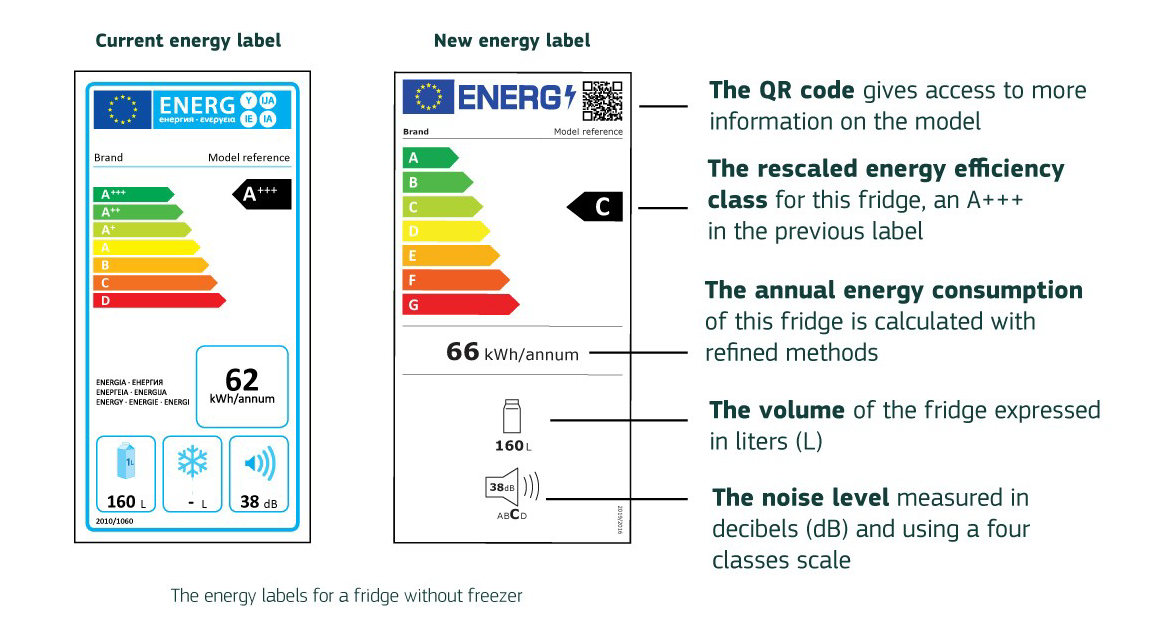Energy Efficiency Ratings
You may have seen reference to the energy ratings for appliances changing in 2021.
Under the old system, appliances such as washing machines, dishwashers, TVs, and fridges were rated on an A+++ to D scale, with more and more appliances over time moving into the A+++ category.
This made it hard to identify the most energy-efficient appliances. To solve this, a simple A to G ranking scale was introduced in March 2021.
Why Is it Changing?
The current energy efficiency rating system was introduced around twenty years ago. Originally, the scale ran from “A” for the most efficient products, down to “F” for the least efficient.
Over time, more and more appliances were moving up into the most efficient category, so A+, A++, and A+++ ratings were added in.
The age of the current system has meant that many major brands have now reached the top ratings in this scale.
In fact, more than 90% of appliances had an A+++ rating under the old system, so working out which product is the most efficient is difficult.

The new A-G system is stricter – and is designed to prevent many companies from immediately reaching the top ratings. This gives room for companies to innovate and create better products going forwards.
The new energy efficiency labels will also feature handy QR codes. Scanning these will bring up additional information about the product and its ratings.
There have been changes beyond simply replacing the rating scale that is being used. For many of the appliances using the new system, there have been fundamental changes in how the energy efficiency is calculated and labelled.
Many people believe that energy efficiency ratings tell you how well a machine performs, but that’s not the case. An appliance with a poor energy rating could still be very good at washing your clothes or getting the dirt out of your carpet. But a poorly rated machine will use more energy and ultimately cost you more money to run.
How are energy ratings calculated?
Because kitchen appliances are all designed to do very different jobs, the tests used to work out their energy efficiency are very different for each type of appliance.
It’s up to the manufacturers themselves to carry out the testing. Plus, all appliances must have technical documents to prove the test results to the right authorities.
Washing machines and washer dryers
Previously, washing machine labels stated their energy ratings based on annual usage, but this is not always the most helpful for consumers.
Instead, the new results on the new labels are based on 100 cycles, making it easier to compare different machines. The new “Eco 40-60” programs can now combine cotton, linen, and mixed fabrics into one efficient cycle too.
Like with washing machines, the new washer dryer energy ratings will be based on 100 cycles instead of annual usage, and washer dryer “Eco 40-60” programs can incorporate mixed fabrics too.
The difference here is that washer dryer labels will be split into two halves. The right side covers just a wash cycle and will be the same as for your bog-standard washing machine. The left side will show the energy rating for a wash and dry cycle.
Dishwashers
Dishwasher energy efficiency tests have been adapted to better reflect how the average household uses their dishwasher and the energy ratings are calculated by how much water they use, compared to the amount of energy they consume over 100 cycles.
Cups, pots, and plastic utensils will now be used to test cleaning and drying performance. The new Eco cycles will be even more energy-efficient than before and will be perfect for normally dirty dishware.
Fridges and freezers
The labels on fridge freezers will now include many more details, such as the room temperature, type of appliance, how it works and the number and size of storage compartments.
The new labels will also include the total volume of both refrigerator and freezer compartments. You will also begin to find details of whether there are any noise emissions.
There are a couple of things you can do to make sure your fridge or freezer runs as efficiently as possible – make sure you don’t over-fill it, de-ice the freezer if it starts to build up. But because refrigeration appliances are switched on all the time, it’s a good idea to pay special attention to that energy efficiency label when you’re shopping for a new fridge or freezer.
Cookers
The energy ratings for cookers are staying just the same. When a cooker’s being tested, the size of the internal space is measured against the amount of energy it uses to heat a brick to 55°C. The less energy used to heat the brick, the better the cooker's energy rating!
The age-old argument when it comes to cooking is ‘what’s best, gas or electric?’ Well, when it comes to energy efficiency, the performance of gas versus electric tends to be roughly the same. Many people prefer the convenience of electricity, but with mains gas costing about 3 times less than electricity, it really comes down to what you prefer and how much you’re willing to spend.
TVs and monitors
The way both TVs and monitors are tested has changed, and the labels have gained a few extra pieces of information too.
Measurements are now given in kWh per 1000 hours to make it easier to compare different TVs and monitors, and new developments like SDR and HDR will be included on the label too.
